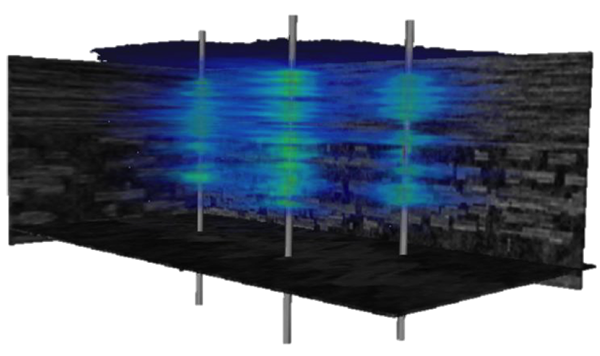Research Theme A
How Much, How Far, How Fast?
Previous research on capacity has focused on static volumetric assessments at regional scales and modeled injection scenarios at reservoir scales. The fundamental research results suggest that capacity is generally available at the volumes and timescales needed. Results at reservoir scale indicate that challenges for representing heterogeneity remain, and that tools are needed for rapid but accurate screening of potential reservoir candidates.

Emerging capacity-related interests are: 1) post-injection performance (during overpressure decay), 2) in understanding the impacts on capacity resulting from stratigraphic heterogeneity at meso-scales (continuum to reservoir block scale), and 3) the potential for pressure build-up to limit injectivity. The first two topics include aspects where fluid transport is likely to be dominated by buoyancy. The implications for key challenges for geologic carbon storage are significant: In buoyancy-dominated flow, CO2 may travel much farther (how far?) than anticipated by conventional modeling/simulation, thereby greatly decreasing volumetric storage efficiency (how much?) and possibly reducing storage security (how fast?). Pressure build up is most strongly related to boundary conditions at both regional and local scales.
Research under this theme anticipates:
- Practical application and further development of EASiTool.
- Seek additional theoretical and field applications of capacity assessment expertise; for example in connection with offshore studies in theme E.
- Evaluating opportunities for modeling and experiments to understand trade-offs between viscus, buoyancy, and capillary forces in realistic situations and the significance of these differences to field studies.
- Application of field project experience to post-injection monitoring design.
- Leverage from CFSES multi-year project:
- Understanding and predicting local capillary trapping in sedimentologically-representative materials at the meso-scale (cm- to- m scale). (how much, how far)
- Seeking an efficiency function that incorporates local rock and fluid properties to predict bulk saturation.
- We will seek opportunities to explore engineered solutions for CO2 EOR and CO2 storage optimization.
- We will investigate active reservoir management by brine production and other relevant operational solutions with the possibility of using produced brine as part of EASiTool. This study will relate the operational strategies affecting reservoir and basin wide pressure increase. We will study ways to control pressure at high-risk locations.
- Seek opportunities to evaluate dissolution and miscibility as limits to migration.




